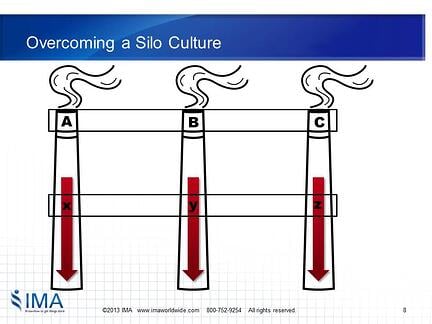So many organizations are moving toward a Shared Services model. The business case for this type of transformational change is undeniably strong. Shared Services consolidates redundant business units used by multiple parts of the organization. When complete, this type of enterprise-wide change has been proven to reduce costs and increase efficiencies. 
But, while a Shared Services implementation can be excellent for an organization’s balance sheet, any seasoned Change Agent knows the journey to get there can be quite long and painful. Think about it. This type of change is complex and more often than not, political. The reality is you’re doing more than just streamlining business functions; you are actually implementing a major cultural change.
Barriers to Change
Like any other enterprise-wide change, there are many predictable obstacles when creating Shared Services. For example, you may well encounter:
- Lack of clear scope/definition
- Too many other changes competing for resources
- Poor implementation history
- No aligned, sustained leadership support
- Major employee resistance
- Weak motivation and non-aligned reinforcement
- Risk-averse cultures
- Poor communications
- Unclear and/or undisciplined governance structure
In addition to these barriers, moving to a Shared Services model (or implementing any other enterprise-wide change for that matter) also involves one of the most challenging barriers of all—attempting to move horizontally across the vertical columns of the organization’s power structures. Essentially, you are asking leaders to “give up power and control” of areas they’ve managed for years. This “silo” mentality has to be overcome in order to have a successful implementation.

Best Practices
In our many years of change management consulting, we’ve identified 6 tips for implementing a Shared Services model. By putting these elements in place, your organization will be better positioned to achieve the intended benefit realization of this frame breaking, transformational change.
![]() #1 Have a Clear Line of Sight Into All Organizational Change (Past and Current)
#1 Have a Clear Line of Sight Into All Organizational Change (Past and Current)
No change occurs in isolation. It occurs in the context of your past history, and all the other changes occurring at the same time. Heat maps are an excellent way to get a line of sight into what else is competing for resources, Sponsorship, time, and energy.
![]() #2 Reinforce Senior Executives Jointly
#2 Reinforce Senior Executives Jointly
These executives have been rewarded in the past for their individual performance and their ability to get things done in a silo'd culture. Now you are asking them to give up power and control. The best way to make that happen is to change the reinforcements so that reward is based on success "of the many," rather than based solely on individual success.
![]() #3 Reinforce Behavior Both Laterally and Vertically
#3 Reinforce Behavior Both Laterally and Vertically
As in Best Practice #2, you will need to create reinforcements that reflect the transformational change you are trying to create. Since behavior follows reinforcement, you will need to create reinforcement systems that align with the Shared Services process flow across the vertical operating units.
![]() #4 Create Common Goals and Mutual Inter-dependence
#4 Create Common Goals and Mutual Inter-dependence
Shared Services works best in a collaborative culture where "everyone is on the same page." One of the best ways to make that happen is by creating an environment of true partnership. Joint goals and recognized inter-dependence between those who are serving (the Shared Services organization), and those being served (business partners), combined with appropriate reinforcements, builds the required collaborative culture.
![]() #5 Create Service Level Agreements
#5 Create Service Level Agreements
These service level agreements provide clarity on roles/responsibilities/and accountabilities. These agreements assure business partners that there is a "contractual agreement" on what services will be provided, and that their needs will be met under the new structure.
![]() #6 Appoint Liaisons
#6 Appoint Liaisons
Just as the service agreements promote confidence in the Shared Services function, this best practice ensures that there are specific individuals who can be called on to ensure agreed service levels are maintained and can resolve any disputes that are going to arise.
Enterprise-wide change will always stir up noise. Shared Services implementation is hardly the exception. By following these best practices and using a structured and repeatable implementation process you will be well on your way to project ROI.


